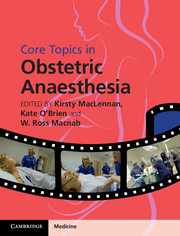Book contents
- Frontmatter
- Contents
- List of contributors
- Preface
- Section 1 Basic science, epidemiology and service organization
- Section 2 Obstetric aspects
- Section 3 Provision of anaesthesia
- Section 4 Medical conditions in pregnancy
- 14 Hypertension in pregnancy, pre-eclampsia and eclampsia
- 15 Sepsis and influenza in pregnancy
- 16 Cardiac disease in pregnancy
- 17 Respiratory disease in pregnancy
- 18 Obesity and ultrasonography for central neuraxial blocks
- 19 Endocrine disease in pregnancy including diabetes mellitus, thyroid and adrenal disease
- 20 Renal disease
- 21 Haematologic disease in pregnancy
- 22 Neurosurgical and neurological disease in pregnancy
- 23 Immunology, including testing and management of allergy during pregnancy
- 24 HIV and infectious disease in pregnancy, including herpes, syphilis and hepatitis
- Section 5 Postpartum complications and obstetric emergencies
- Section 6 Service organization
- Index
- Plate section
- References
16 - Cardiac disease in pregnancy
from Section 4 - Medical conditions in pregnancy
Published online by Cambridge University Press: 05 December 2015
- Frontmatter
- Contents
- List of contributors
- Preface
- Section 1 Basic science, epidemiology and service organization
- Section 2 Obstetric aspects
- Section 3 Provision of anaesthesia
- Section 4 Medical conditions in pregnancy
- 14 Hypertension in pregnancy, pre-eclampsia and eclampsia
- 15 Sepsis and influenza in pregnancy
- 16 Cardiac disease in pregnancy
- 17 Respiratory disease in pregnancy
- 18 Obesity and ultrasonography for central neuraxial blocks
- 19 Endocrine disease in pregnancy including diabetes mellitus, thyroid and adrenal disease
- 20 Renal disease
- 21 Haematologic disease in pregnancy
- 22 Neurosurgical and neurological disease in pregnancy
- 23 Immunology, including testing and management of allergy during pregnancy
- 24 HIV and infectious disease in pregnancy, including herpes, syphilis and hepatitis
- Section 5 Postpartum complications and obstetric emergencies
- Section 6 Service organization
- Index
- Plate section
- References
Summary
Cardiac disease is a significant cause of maternal mortality worldwide. In the last UK maternal mortality report, cardiac disease was the leading cause of maternal death (2.3 deaths per 100000 maternities). Some mothers are waiting to have a family later in life and present with a variety of acquired heart conditions. There is a 1% incidence of heart disease in pregnant patients in the UK, which has reduced from an estimated 3% incidence due in part to a reduction in rheumatic heart disease. However, it is expected to increase as the number of patients with corrected congenital heart disease surviving to childbearing age increases and may also increase further as immigration patterns change. The incidence of cardiac disease is in the order of 0.2–4% in the Western industrialized countries and is about 4% in the United States. Congenital heart disease accounts for 75–80% of cardiac disease in pregnancy in the western world. Outside Western Europe and North America congenital heart disease accounts for only 9–19% of the cardiac disease in pregnancy. In non-Western countries rheumatic valvular disease causes 55–89% of cardiovascular disease in pregnancy.
Of patients with congenital heart disease, 96% will live for at least 15 years if they survive infancy. It is therefore essential to have a good knowledge of these cardiac conditions and a good understanding of the stresses on the cardiovascular physiology caused by pregnancy. These patients can turn up on any delivery suite in any hospital at any time.
Physiology
Important physiological changes in the cardiovascular system need to occur during pregnancy in order to facilitate the increased demand for oxygen and nutrients by the uteroplacental unit, and that of the growing fetus. Blood flow to the uterus increases from 50 mL/min at 10 weeks’ gestation to 850 mL/min at term. This is accomplished by a 50% rise in cardiac output (CO) and blood volume. There is an increase in heart rate from 6 weeks. There is a reduction in systemic and pulmonary vascular resistance due to vasoactive prostaglandins and nitric oxide production, thus preventing a rise in pulmonary artery pressure from the increased circulating volume. The systolic and diastolic pressures decrease, reaching their lowest values during the second trimester, before increasing as term approaches, although never reaching prepregnancy values. Therefore, there is a risk of cardiac decompensation as pregnancy progresses.
- Type
- Chapter
- Information
- Core Topics in Obstetric Anaesthesia , pp. 114 - 122Publisher: Cambridge University PressPrint publication year: 2015



